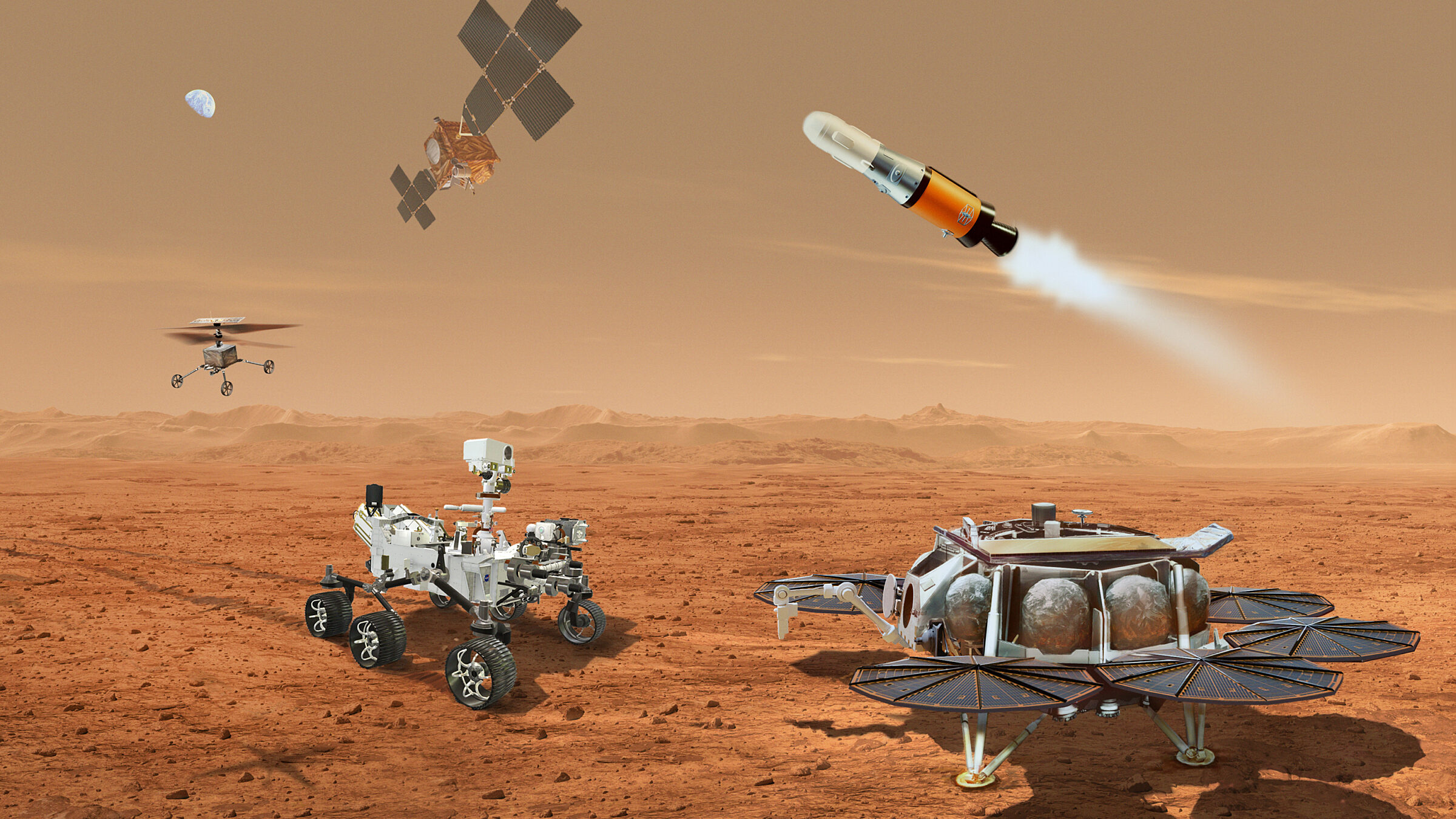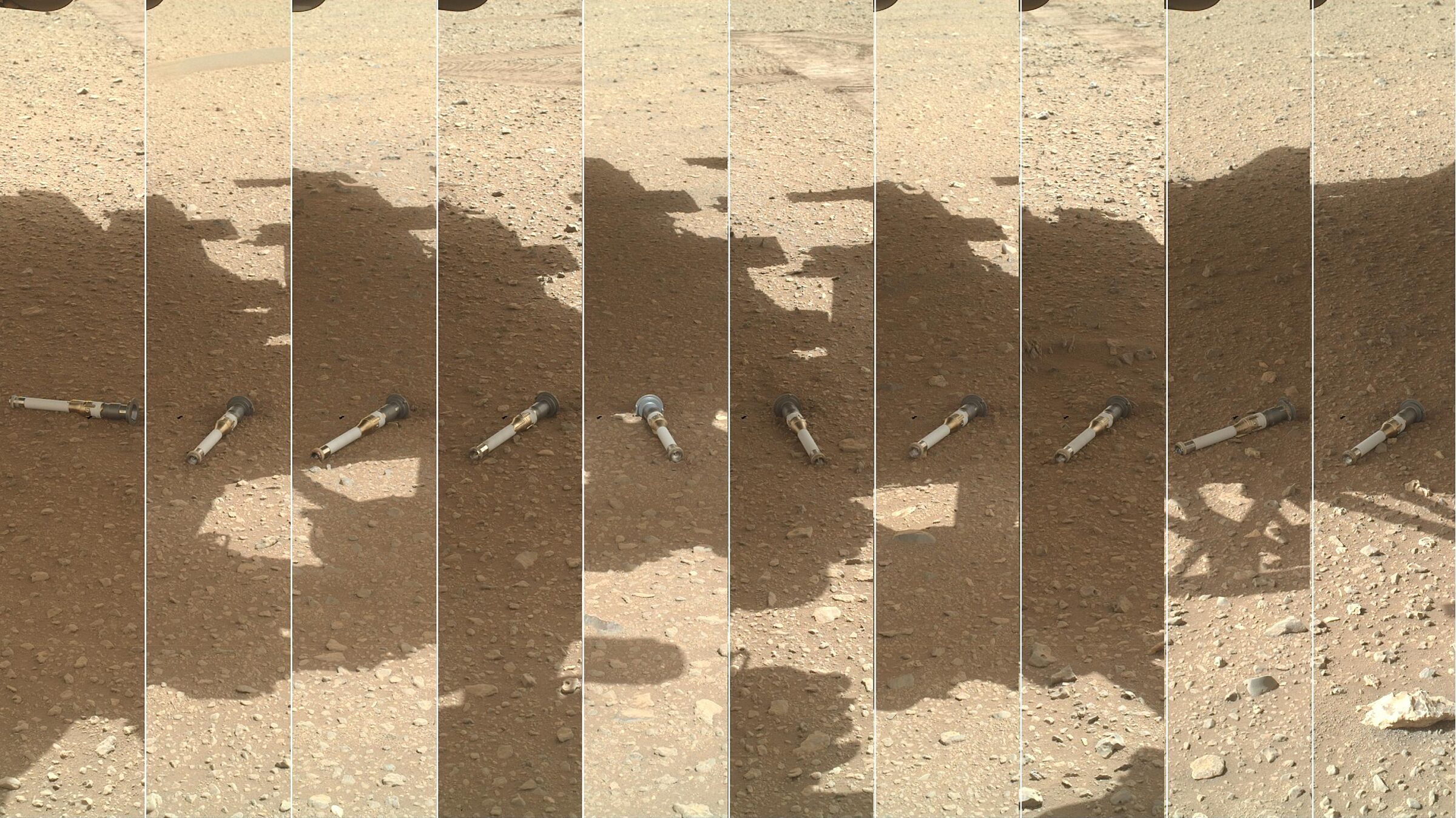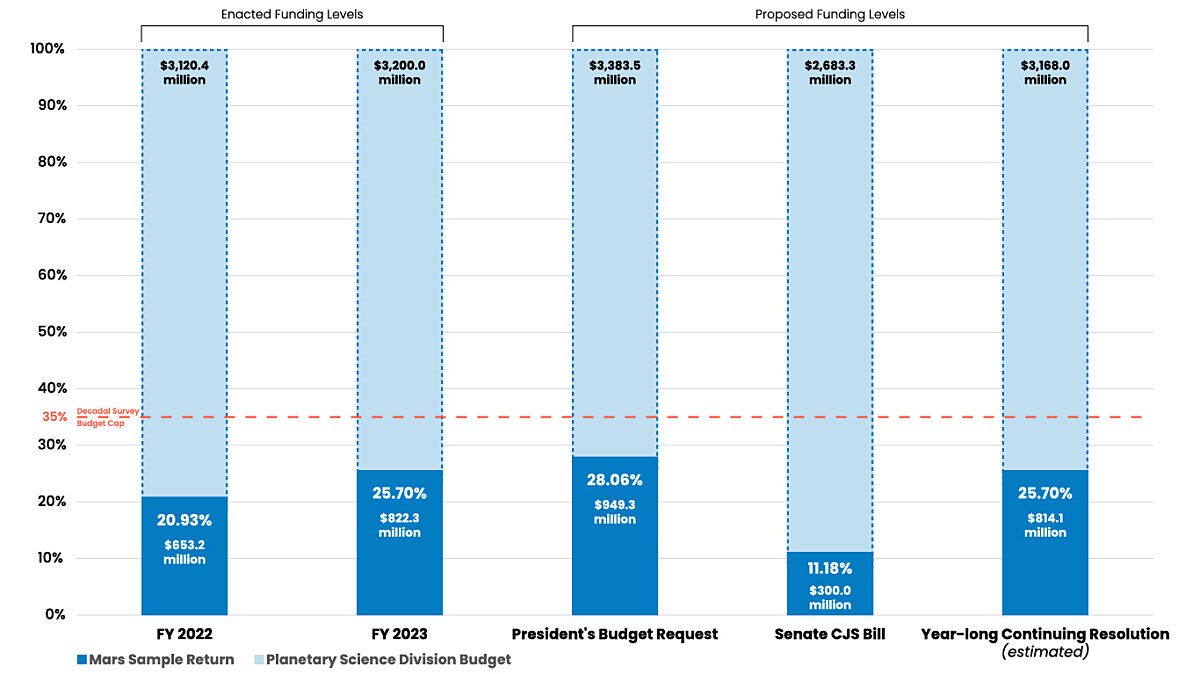Jack Kiraly • Oct 05, 2023
The future of Mars Sample Return
Independent review reinforces imperatives of sample return, warns of stumbling blocks impeding program
The long-awaited report from the second Mars Sample Return (MSR) Independent Review Board (IRB) is out and sheds light on the distinct challenges of what is one of the most ambitious endeavors in the history of robotic space exploration. This mission is not only pivotal for scientific discovery but also holds implications for future human missions to Mars.
The joint U.S.-European collaboration to return samples collected by the Perseverance rover is now estimated to cost between $8.4 and 10.9 billion, making it the most expensive robotic planetary science program since the Viking landers. To enable the greatest chance of mission success, the report recommended significant changes to the program's management structure and determined that the launch readiness for the multi-phased mission will shift to the early 2030s.
Despite the cost, schedule, and management concerns, the IRB advocates for the immense significance of the samples already and about to be collected, and implores NASA to restructure the program to meet the two-time Planetary Science Decadal Survey top priority of returning samples from Mars. NASA has delayed confirmation of the spacecraft design until after they release a formal response in early 2024.

The goal of MSR is to return scientifically significant samples collected in and around Jezero Crater by the Perseverance rover for further study in state-of-the-art laboratories on Earth. But as the IRB points out, to call this feat a singular mission is incorrect; the MSR program comprises three distinct flagship-level components in addition to the flagship-level Perseverance rover that is already gathering samples:
Sample Retrieval Lander (SRL) - the largest object to ever land on Mars, responsible for collecting the samples from the Perseverance rover
Mars Ascent Vehicle (MAV) - the first rocket to launch off another planet, responsible for getting the Orbiting Sample (OS) container to orbit
Earth Return Orbiter (ERO) - built by the European Space Agency (ESA), with the Capture, Containment and Return System (CCRS) provided by NASA, responsible for autonomously tracking, rendezvousing, and returning the OS to Earth
Speculation about the contents of this report swirled in news and social media, with the potential outcomes ranging from rubber stamp to immediate cancellation of the program. And although the IRB is highly critical of the current architecture and management of MSR, it chastises NASA in the way of a stern parent wanting a child to succeed following bad marks in school. The report reinforces a number of imperatives, scientific and otherwise, about the program.
MSR aligns with NASA's Moon-to-Mars strategy, emphasizing the nation's leadership in space exploration and commitment to the long-term goal of sending humans to Mars. MSR would be a demonstration of NASA’s evolving ability to land larger and larger objects on the surface and, for the first time, the capability to launch an object off of Mars and into Mars orbit for rendezvous with a spacecraft for return to Earth. With human exploration of Mars as the horizon goal of the Artemis campaign, demonstrating this return trip, even if only for 500 grams of samples, is highly relevant to future human missions. And much like the Surveyor spacecraft before the Apollo missions, the samples will inform NASA about the properties of Martian rocks and regolith needed to prepare for human exploration and protect future astronauts and their equipment.
NASA also plays a critical role in the arsenal of American diplomacy, offering “soft power” to facilitate international cooperation and promote the values system of the United States. ESA is a key partner on MSR and ensuring that their investment is respected not only ensures the safe return of the samples, but strengthens ties during a period of geopolitical tensions in Eastern Europe. China's announcement of its own intention to mount a Mars sample return mission in 2030 underscores the global competition in Mars exploration.

And foremost of all, the IRB aptly identifies MSR as the culmination of four decades of Mars exploration. Returning samples has been a driving goal of the planetary science community since the Viking mission in the 1970s. The IRB report reinforces the importance of a carefully selected suite of samples collected with geological context and spanning rock types and rock ages. While Mars meteorites have brought tough Martian igneous rocks that are little-affected by water to Earth labs, the Perseverance sample collection includes sedimentary rocks, hydrothermally altered rocks, and water-altered rocks that preserve the history of climate and potential habitats for life. In light of the recent Decadal Survey, the second in a row that endorsed Mars sample return as the highest priority goal of NASA’s planetary science program, this IRB demonstrated rock-solid support for the program’s science goals.
The lunar samples returned during the Apollo missions reshaped and continue to shape our understanding of the early Solar System. For example, the availability of water on the Moon, which is guiding the strategy for future Artemis missions, was a discovery made in 2008 from further analysis of Apollo samples. MSR aims to similarly revolutionize our knowledge of Earth-like planets. The samples from Mars collected by the Perseverance rover are from a region that once harbored a Mars lake and are invaluable in this quest, necessitating the use of state-of-the-art Earth laboratories for detailed analysis.
And more recently, the asteroid samples returned from the OSIRIS-REx mission have reignited the public’s interest in this method of discovery. With those samples set to uncover mysteries about the chemical composition of the early Solar System, the samples collected by the Perseverance rover will address the evolution of the terrestrial planets, and potentially, the origin of life.

To return samples from Mars is no small feat and the IRB expects it to come at a new, higher price point. Specifically, the report indicates the lifetime cost of MSR is estimated to be between $8.4 and $10.9 billion. Part of this cost increase is due to “de-risking” the mission by allowing it to utilize launch opportunities in later years. The report points out that this is in addition to the roughly $20 billion that the United States government has invested over the past 30 years of Mars exploration, which enables the realization of sample return.
A major theme within the Decadal Survey is overall programmatic balance within the Planetary Science Division (PSD) budget, and a major priority of The Planetary Society is that the balance within planetary exploration is maintained across all of NASA’s diverse science disciplines. While MSR is a critical next step in planetary exploration, it is still not a mission that must be done “at all costs.” According to the Decadal guidelines, the budget for MSR should not constitute more than 35% of the overall PSD budget in any given year. In the recently concluded Fiscal Year 2023, MSR accounted for 25.7% ($822.3 million of $3,200.0 million) of the PSD budget. In the President’s Budget Request for FY 2024, MSR grows slightly to 28.0% ($949.3 million of $3,383.5 million). The U.S. government is funded at FY 2023 levels until the expiration of the Continuing Resolution on November 17, 2023. Funding for FY 2024 is uncertain, as multiple proposals exist as of publishing.
The IRB estimates that it could cost between $850 million and $1 billion per fiscal year, depending on mission implementation details, to conduct a robust and resilient MSR program. If PSD funding is kept flat at FY23 levels, this represents 26.5 to 31.3% of the annual budget. A mission plan must be developed that achieves MSR’s objectives while staying at or below the Decadal’s proscribed 35% limit, in order to maintain and even grow the diverse array of planetary science missions and research required for a balanced program.
This price tag may seem exorbitant while other space science priorities are feeling budget woes; a natural reaction would be to suggest shifting funds from one program line to another in the name of balance. The IRB cautions against this thinking; funding for planetary science is not a zero-sum game. As evidenced by the U.S. Senate’s proposal to gut MSR earlier this year, cancellation of MSR would remove funding from NASA’s science missions entirely. This further emphasizes the importance of following the Decadal recommendations and budget guidance to support a balanced program of small, medium, and large missions, as well research funding that maximizes the scientific output of existing missions, expands our understanding of the Cosmos, and trains the next generation of scientists.
In addition, the IRB report indicates that achieving a 2028 Launch Readiness Date (LRD) is not possible, and even 2030 would be ambitious under the current program architecture. This shift to 2030 necessitates NASA identifying alternative architectures and a rephased cost plan for the program. In the context of the imperatives to complete the project, the report underscores the importance of securing adequate funding and addressing outstanding issues to adhere to the revised 2030 (or beyond) launch timeline.

There are other alternative launch windows in the early 2030s, as noted in the report, but a key consideration here is the long-term health of the existing orbiters and the Perseverance rover into the next decade. The later into the 2030s the project’s launch date goes, the greater the risk to NASA that current assets will not be able to support the landing, retrieval, launch, and capture of the samples. And given the lesser scientific value of the samples currently available at the Three Forks depot versus those currently onboard and still to be collected by the Perseverance rover, the architecture NASA confirms should be focused on returning the high value sample set that also includes those from the crater rim and beyond. This shows that the IRB reinforces the conclusions of two Decadal Surveys that MSR keep focus on a concentrated and thoughtful collection of samples that can give current and future scientists a glimpse into the diverse geologic history of Mars.
As the most ambitious planetary science program to date, the project spans multiple NASA centers, contractors, and international partners. A program of this scale, importance, and complexity necessitates tight organizational efficiency and coordination between these stakeholders. However, the report details current managerial inefficiencies that compound the technical challenges.
A recurring theme in this vein is the need for much better and clearer communication. The IRB notes that NASA has not been consistent in conveying the significance of MSR to various stakeholders, including Congress, the scientific community, and the general public. Sharing and communicating the importance and relevance of planetary missions like MSR is a key goal of The Planetary Society, and we are eager to contribute our members’ voices to this important national and international conversation.
On the technical side, the IRB found that the current mission architecture lacks resilience against potential delays or unforeseen cost overruns. NASA is urged to explore alternative architectures to bolster the mission's resilience and technical feasibility. The IRB recommends decoupling the development of the ERO and SRL, and should be treated as standalone mission elements. Additionally, the design for the Orbiting Sample (OS) container is yet to be finalized, and there's an evident gap in a coordinated effort to address Backward Planetary Protection (protecting life on Earth from any potential contamination).
Overall, the report is a significant and highly critical wake-up call for NASA to reform MSR management and its technical implementation. Since release of the report, NASA has officially delayed the Key Decision Point C review (also referred to as confirmation) of the Mars Sample Return program until they can appropriately respond to the findings and recommendations, likely in early 2024. Despite the uncertainty created for the program earlier this year, however, the IRB reinforces the dual-Decadal priority of returning samples as a critical goal for the future human exploration of Mars.
The MSR program represents a monumental investment and challenge, with the opportunity to achieve a feat of great scientific and historical significance. As NASA and ESA navigate the complexities of this mission, clear communication, strategic reorganization, financial prudence, and technical foresight will be paramount. The stakes are high, but the potential rewards for science and humanity are even higher.
If you support Mars Sample Return and a balanced budget for planetary science, The Planetary Society has a letter you can send to Congress right now to advocate for these Decadal priorities.


 Explore Worlds
Explore Worlds Find Life
Find Life Defend Earth
Defend Earth

